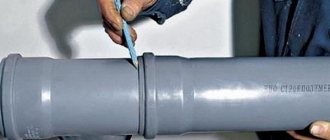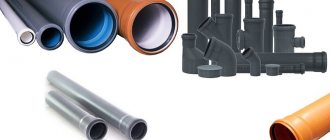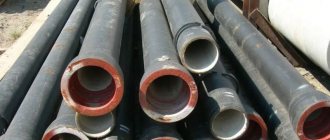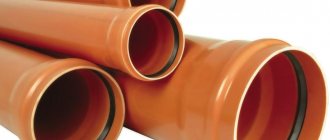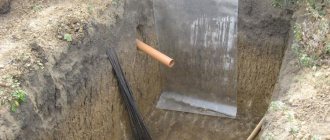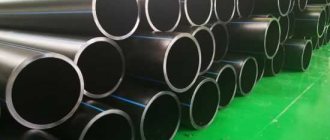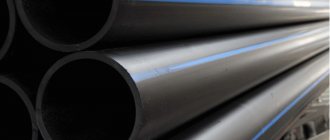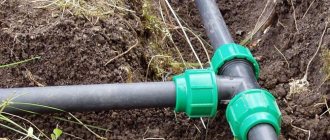Arranging a country house in the absence of common communal water supply and sewerage systems is a difficult task for any homeowner. In addition to providing residents with drinking water, it is necessary to solve the problems of draining gray water and sewage, while not forgetting about the insulation of external sewer pipes.
This problem can be solved in various ways; to select the appropriate option, it is useful to know how external sewerage pipes in the ground are insulated and to study this technology. This will allow for proper and long-term insulation of the sewer system with minimal time and financial losses.
Rice. 1 Sewerage of a private house - device
Is it necessary to insulate the sewer system and problems when pipes freeze?
When draining sewer and gray water from a private house at sub-zero ambient temperatures, they can freeze, and this will cause the following unpleasant consequences:
- Frozen water will prevent drainage from the house, thereby creating significant difficulties for living in the private sector in the winter.
- Also, when defrosting, water expands, which causes damage to pipelines and clogging of the ground with sewage, worsening the environmental situation.
- Ice plugs that prevent the outflow of contaminated water will cause it to stagnate in the drainage system - as a result, unpleasant odors will appear in the home, interfering with comfortable living.
Rice. 2 Map of soil freezing level - example
Polyurethane foam shells
Polyurethane foam cylinders are a good alternative to their foam counterparts. They differ in comparison with their higher density, and the thermal conductivity coefficient is almost the same.
Polyurethane foam also has higher resistance to mechanical stress. It also has a wider temperature range in which it can be operated without loss of strength characteristics.
The normal temperature regime for polyurethane shells is -180⁰ – +130⁰. This material also has a high fire safety indicator - it lights up at 415⁰ and subsequently self-extinguishes
Thermal insulation has the form of half-cylinders equipped with transverse or longitudinal latches. To increase the reliability of protection, the shells are sometimes enclosed in special galvanized casings equipped with locks, but more often they are simply coated with a special coating.
Insulation of external sewer pipes - generally accepted methods
When deciding how to insulate a sewer system in a private house, a number of methods are considered, the main ones being:
- Depression in the ground. To implement this method, a prerequisite is to place the pipe outdoors in a trench below the maximum freezing point for the given area.
- Using an electrical cable. This technology for insulating external sewers is easily implemented thanks to the manufacturer, which produces reliable moisture-resistant electric heating cables placed inside the pipeline or special sockets in the pipes.
- The use of insulation. This method of thermal insulation can be quite simply implemented thanks to the shells produced from various types of insulation with a diameter suitable for sewer insulation.
- Combined methods. An excellent solution for thermal insulation of sewer pipelines is the use of additional insulation by placing them in a shell of insulation at an average depth in the ground. Another common option is to place the heating electric cable in a sheath of insulation, while the sewer line is located at a short distance from the surface of the earth.
Rice. 3 Installation of pipes in a trench
Criteria for choosing a riveter
In the most general form, we discussed the question of how to use a riveter above; you can find out in more detail in specialized literature or watch a video on the Internet.
Let's try to outline the criteria for choosing this highly specialized tool.
When purchasing, as a rule, four nozzles for the riveter are included in the kit; if this is not enough, you need to take care of additional nozzles; they can be purchased separately.
In general, answering the question: how to choose a riveter, we note that it would be better to choose a tool of higher quality; although it is more expensive, it lasts longer and the quality of the resulting connection is higher.
Insulation using soil when laying a pipeline below the freezing depth
Insulating sewer pipes in the ground using this method is the most affordable process, because in areas with a temperate climate, the depth of soil freezing is about 1.5 meters. When determining the depth, you can be guided by special ground freezing maps for different regions; laying a pipeline below the freezing depth has the following features:
- When installing a pipeline in the middle zone or northern latitudes, a large amount of excavation work will be required - this will lead to high financial costs.
- The volume of land sampling and costs will increase even more if the distance of the sewer line from the house is too large, because along the entire route it is 110 mm. the pipeline must provide a minimum technical slope of 20 mm. per linear meter. Compliance with this condition leads to the fact that at a 50-meter distance the height difference can reach one meter - therefore, the lowest point will be at a depth of 2.5 meters.
- The deep location of the pipeline underground makes it difficult to carry out repair work in case of damage.
Fig. 4 Thermal insulation of sewerage with a heating cable - type of wire
Related article:
Sewerage in the country - options, design diagrams and installation. If you need to install a sewer system in your dacha, then in a separate article read about all the possible expensive and cheap options for arranging a sewer system in your dacha. Nuances, types, schemes.
Thermal insulation with foam rubber
This insulation is made on the basis of natural or combined rubber and is classified as elastomers. That is, to materials with a high elasticity index. It is worth noting that the insulation is installed using the hot stitching method, after which a strong seam is formed. To simplify installation work, some manufacturers produce rubber hollow cylinders with a technical cut, on the edges of which there is already an adhesive layer under a protective tape. To attach such insulation to a pipe, it is enough to remove the protective strip and firmly connect the ends of the two halves.
Synthetic rubber has a fine, closed-cell structure, which gives it a number of advantages:
- Low thermal conductivity;
- Resistance to moisture and steam, which lasts throughout the entire service life;
- The material has excellent adhesion properties to any surface at the molecular level;
- Due to its high flexibility, it is possible to perform hermetically sealed thermal insulation;
- Retains its properties even with sudden changes in high temperatures (from -200 to +150°C). This makes it possible to use it in harsh climatic zones;
- Durability without loss of quality;
- High noise insulation properties;
- The material contains a large number of fire extinguishing additives. This is an extremely important point when it is necessary to carry out insulation work in areas with a high fire hazard;
- Absolutely safe for health, hygienic, non-toxic;
- The ability to reuse insulation, which makes it cost-effective.
produced in the form of sheets or hollow tubes , is suitable for insulating insulating pipes . It has a standard cross-section for pipes with a diameter from 6 to 114 mm. The insulation thickness reaches 6 -32 mm. Sheet rubber is used for larger diameter pipes. The material is fixed in the same way as polyethylene sheets.
Heating of external sewerage using cable
When deciding how to insulate sewer pipes in a private home, many choose a heating cable. During installation, it is placed along or wrapped around the pipeline, if strong heating is required; a common option is to place the heating wire inside the pipeline. The use of electric heating has the following features:
- Electric cable is quite expensive, the price of one linear meter is approximately 15 USD.
- With electrical heating, it is possible to place the sewer line in the ground not too deep; its usual depth is no more than 0.5 meters and can be reduced by using a powerful electric cable with a small winding pitch.
- The heating wire can be placed in pipe channels specially made for its installation or attached to a plastic pipeline with your own hands using foil adhesive tape.
Good or bad
The high price of a heat-insulating material does not always indicate its excellent properties. There are unscrupulous manufacturers, and among sellers there are those who like to “inflate” the price. Before choosing and buying insulation, you need to thoroughly study its characteristics and think carefully about everything. It is very good if you can get a sample and conduct some experiments:
- Bring a small piece of thermal insulation material to a bright lamp. Translucent - bad. If sewer pipe insulation allows light to pass through, heat will also pass through it. Such a check is not necessary for materials with additional coating (foil and the like).
- If we are talking about foam material, you need to look at the cut. The air cells should be small, ideally approximately the same. Large air chambers will not retain heat well.
- Set the sample on fire. High-quality insulation does not burn. Some materials for heat insulators are initially flammable, which can be eliminated with the help of special additives.
- Try to pull and tear a fragment of the heat insulator. If this happened very easily, the strength is in doubt. Such material can simply be accidentally damaged during the installation process.
This due diligence will help you make your final choice.
Insulation using thermal insulation materials
When determining how to insulate a sewer pipe on the street, insulation is often chosen using insulation materials widely used in the construction industry. Typically, for ease of installation, they have a cylindrical shell with an internal diameter corresponding to the standard size of a sewer pipe.
Glass wool
The main element of this heat insulator is long glass filaments, which are obtained from broken glass by heating to 40º C and blowing from a centrifuge - this significantly reduces the cost of the manufacturing process.
Rice. 6 Insulation for sewer pipes made of glass wool
Fibers with a thickness of 3 - 15 microns. are suspended in the air, so the material has a low density and high resistance to vibration; in addition, glass wool has the following useful properties:
- The material is non-flammable, has high heat resistance and can withstand temperature ranges from -400 to +700 C.
- Its thermal conductivity ranges from 0.045 to 0.065 W/m*C., which is a rather low indicator, second only to some polymer materials.
- Glass wool allows steam to pass through and is not afraid of moisture; it is resistant to a large number of aggressive chemicals and biological effects.
- The material is environmentally friendly and harmless to human health.
The disadvantages of glass wool as insulation include its low density, tendency to shrink and inconvenience of installation.
Glass wool is produced in rolls and slabs; foil cylindrical shells with the appropriate internal diameter are most suitable for sewer insulation.
When installed under a layer of earth, glass wool will be subjected to compression and can absorb moisture - this significantly reduces its thermal insulation properties and limits its use as a heat insulator for the sewer line.
Fig.7 Thermal insulation of sewer pipes in the ground with mineral wool
Mineral wool
Mineral wool is produced in two types - slag wool and basalt. The first has low density and high water absorption, it is not recommended for use on metal surfaces and in residential areas - due to these properties it has very limited use.
Basalt mineral wool, which is produced by melting basalt and forming thin fiber from it, rightfully occupies a leading position among insulation materials, having the following useful properties:
- Low thermal conductivity 0.04 W/m*C. promotes the widespread use of the material in the construction industry for insulation of various types of surfaces and pipelines.
- The material is non-flammable, resistant to many chemicals and temperature changes, and is environmentally friendly.
- Cotton wool is resistant to moisture, but can absorb it, so it is recommended for use in a dry environment.
- Unlike glass wool, basalt wool has a higher density, making it easier to install and more efficient to use under surface pressure conditions.
For insulation of pipelines, basalt wool is produced in the form of segmented cylindrical rolls, often with a foil coating.
Although basalt wool has a high density and can go deep enough into the ground without changing its thickness or losing its properties, its ability to absorb moisture limits the use of the material as insulation.
Rice. 8 Izolon - appearance and application
Thermal insulating paint as insulation
Visually, heat-insulating paint resembles regular paint. Its advantage is that it can be applied to a surface of any shape. A layer of paint forms a sealed elastic coating that works on the principle of a thermos.
The coating with high energy-saving characteristics is a multi-level system, which includes evacuated microspheres of various types, an acrylic binder, and modifying additives that resist the appearance of rust on the surface of metal pipes and mold
To produce microspheres, ceramics, perlite, foam glass and other substances with thermal insulation properties are used. The paint is very easy to use and creates a durable coating.
The effect of coating with such paint is the same as that of insulation with mineral wool or expanded polystyrene. It is applied either manually using a roller or brush, or by spray.
How to insulate a sewer system in a private house
If there is a need to insulate a plastic sewer pipe in a house, you can use all of the above materials. From an economic point of view, ease of installation and aesthetics, the largest number of homeowners prefer isolon. It is simply fixed on the insulated surface through a side cut, and can be glued or connected with adhesive tape. An additional advantage of the material is its highest noise absorption among all heat insulators.
Fig. 11 Insulation of external sewer pipes in a private house with isolon
When deciding how to insulate underground sewers, they take into account climatic conditions, ease of work, and cost of materials. The optimal choice of insulation for underground sewerage, with a wide variety, is not too large - it can be an electrical cable or a shell made of hard, moisture-impervious materials - polystyrene foam or polystyrene foam. Often a combination of a heating cable and an insulating shell is used for thermal insulation.
Installation process
We will analyze the procedure for insulating the sewer system using the example of the shape of the shell, because other forms are installed similarly. The process of installing roll insulation is intuitive - cut into pieces and fix on the pipeline.
So, the sequence is as follows:
1. The halves of the material are simply put on the insulated element. They are installed with an overlap of up to 20 cm.
2. The overlap points are fixed with tape.
3. The parts are also connected using tape.
4. To insulate the corner of the sewer pipe, you need to select the appropriate shaped shell.
5. In some cases, you can use an additional outer protective layer.
